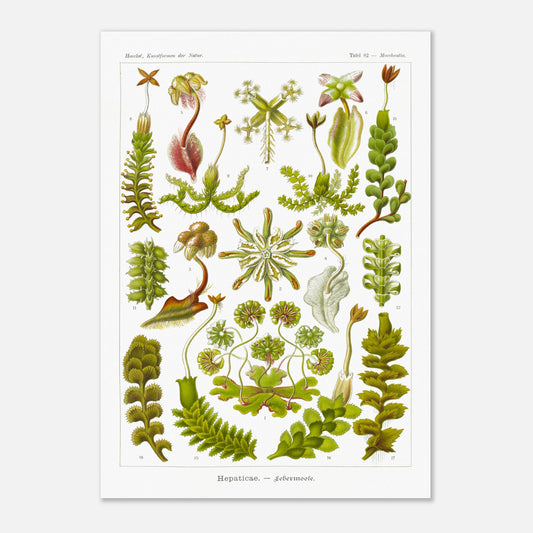Liverworts - Scientific Art Reproduction - Ernst Haeckel, Kunstformen der Natur
Liverworts - Scientific Art Reproduction - Ernst Haeckel, Kunstformen der Natur
Couldn't load pickup availability
Reproduction engraving of: Liverworts
Original title Hepaticae - Lebermoose
Poster of Marchantia - Bryophytes of the class Liverworts (Hepaticae)
Illustration from the book Kunstformen der Natur, which is a collection of artistic lithographs of natural sciences published by the German biologist Ernst Haeckel between 1899 and 1904.
This naturalistic illustration is part of an overall style inspired by Ernst Haeckel, which greatly influenced the emerging Art Nouveau movement at the beginning of the 20th century. This work, illustrating the impressive beauty and great diversity of the biological world, was complemented by a certain amount of scientific information, some excerpts of which are reproduced below.
This information is over 120 years old and some of it may be outdated!
Scientific classification:
Phylium of Embryophytes (Diaphyta or Archegoniata) Main class Bryophytes (Bryophyta) Class of Liverworts (Hepaticae)
Scientific notice (extract) accompanying the poster print of Hepaticae - Hepatics :
The small and delicate prothallus-bearing plants that are grouped in the form-rich class of Liverworts (Hepaticae) can be divided into two different subclasses, the thallus-bearing liverworts and the leaf-bearing liverworts. The oldest and most primitive subclass is the thallus-bearing liverworts (Thallobryia, Fig. 1-7); in these, there is as yet no differentiation between stem and leaf, their multicellular body therefore forms a simple thallus structure, as in the algae (Plates 15 and 65) and fungi (Plates 63 and 73); they are directly related to the green algae (Chlorophyceae), from which they are descended (the Ulvaceae among the latter lead to the Ricciaceae among the liverworts). The most recent and most evolved subclass is the leaf-bearing liverworts (Phyllobryia, Fig. 8-17); in them, the opposition between stem and leaf is already developed, as in the more evolved mosses (Muscinae, Plate 72). The developmental history of liverworts is, like that of mosses, linked to an alternation of generations (Metagenesis). From the fertilized ovule (or stem cell, Cytula), which is produced by the first sexual generation, a second asexual generation develops in the form of a spore-bearing capsule (Sporogonium, also called "moss fruit", "moss urn", etc.). This brown, yellow or red spore-bearing capsule is generally ovoid, often carried by a long peduncle and usually opens at maturity into four valves, thus releasing the mass of small germ cells or spores which it contains (Figs. 8-10, 13, 15 and 16). From each spore, a plant of the sexual generation develops during germination, the flowering moss (Bryogonium); this develops in thallus-bearing liverworts (Fig. 1-7) into a simple leaf-like thallus, in leafy liverworts (Fig. 8-17) into a leafy stem. Later, the moss flowers develop on this, composed of small male sperm receptacles and larger female egg receptacles. In the sperm receptacles (antheridia or spermaria) motile flagellated cells (sperm with two oscillating flagella) are formed; in the egg receptacles (archegonia or ovaries) large individual ovules are formed. After the latter have been fertilized by the former, the sporogonium, the "moss fruit", develops. In many thallus liverworts, elegant inflorescences (Receptacula) are formed, the flowers being surrounded by a floral envelope (Perianthium) and grouped together, as in the Marchantiaceae (Fig. 1-7).
Species present on the naturalist plate of Liverworts - Marchantia :
- Marchantia nitida
- Marchantia polymorpha
- Fimbriaria marginata
- Fimbriaria venosa
- Fimbriaria cubensis
- Fimbriaria sanguinea
- Linularia cruciata
- Jungermannia ventricosa
- Jungermannia conniveus
- Lepidozia reptans
- Jubula hutchinsiae
- Harpalejeunia ancistrodes
- Scapania undulata
- Scapania subalpina
- Scapania umbrosa
- Scapania nemorosa
- Scapania aequiloba
About this print
About this print
The layout and composition of this reproduction have been the subject of our greatest attention.
- Respect for the format of the original work: in order to faithfully transcribe the artist's intention, the work is not cropped/re-cut except in extreme cases (obvious imperfection, geometry problem, etc.) in which case the cropping will be as light as possible.
- The presence of white margins is sometimes necessary in order to present the work in a balanced manner.
- Each size offered has been specifically composed, therefore, the size of the white margins may vary from one print size to another. Remember to check this detail carefully!
- Print only, frame not included!
Features
Features
- Premium 200gsm matte white paper, durable and strong.
- Natural, smooth uncoated finish, silky to the touch
- FSC certified paper or equivalent certifications depending on regional availability.
- Each print is shipped in sturdy packaging, ensuring safe transport.
- Each print is printed and shipped on demand. No minimum order quantity is required.
Share !









Recently viewed products
We are listening to you
If you are looking for a specific composition, a particular layout, or any other customization need, our team is at your disposal and will do everything possible to meet your requests.
So don't hesitate to...




